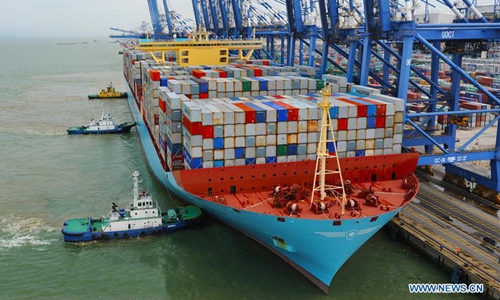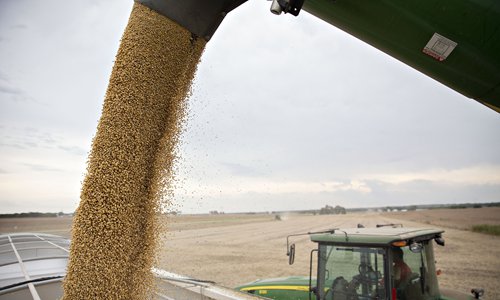
Photo:Xinhua
China and the US have agreed on the text of a highly anticipated phase one trade agreement, under which Washington has committed to roll back tariffs in phases and Beijing will increase its purchase of US products based on market demand, Chinese officials announced on Friday night, marking a milestone first step in resolving the 20 month-long trade war that has dragged economic growth around the world.
The market cheered the news as a precious respite for China and the US whose economic relations were soured by the protracted dispute.
In response to the US tariff rollback, China will consider not imposing tariffs on more than 3,300 types of US goods, including auto parts and chemicals due on December 15, Chinese officials disclosed.
China will also expand agricultural imports from the US, including soybeans, poultry and pork to fill up vacancies in China's domestic market.
The text of the phase one deal includes nine chapters ranging from intellectual property rights, technology transfers to the exchange rate and agriculture. More detailed terms and data will be released later.
Chinese economists hailed the deal as "exciting" as it marked a long-awaited easing of the two countries' economic relations.
"This is a choice of reason and a solution to practical problems. If we don't solve the problems, they will hurt both countries," said Bai Ming, an economic expert close to the Ministry of Commerce.
"The US has shown a positive attitude by cutting some of the tariffs. They are not showing enough of it, but it's an improvement," he said.
The trade volume involved in the China-US trade war is unprecedentedly large, and it is understandable that the US needs to remove tariffs in stages, which could include a possible rollback of new levies scheduled to take effect on Sunday, said Mei Xinyu, an expert close to China's commerce ministry.
Mei told the Global Times on Friday that the agreement on the text of the phase one deal does not mean that all trade issues can be resolved, and any “accidents” could happen during the implementation. “The Chinese government should be prepared at any time to deal with [any changes].”
Wei Jianguo, former Chinese vice minister of commerce, called the deal a "phased victory" for China, not only because of the terms included but also because it reflects a shift in the philosophy of US authorities - a departure from their arrogance when they initiated the trade war.
"The trade war has taught the US a lesson. They finally realized that engaging in a prolonged trade war will bring no good to itself, and that ending it as soon as possible is their best option," he said.
The world's two largest economies have been locked in a bitter trade battle for nearly two years. The dispute has seen both countries impose tariffs on hundreds of billions of dollars in each other's goods.
Washington slapped three rounds of tariffs on Chinese imports last year, and a fourth one in September. Beijing hit back with tariffs ranging from 5-25 percent on US products.

Soybeans are loaded into a grain cart during harvest in the US state of Illinois in 2018. Photo: VCG
The financial markets absorbed the news. By 11:19 pm Beijing time, the Nasdaq Composite Index was up 0.29 percent, while the Dow Jones Industrials rose by 0.28 percent.
The A-share market soared on Friday, with the benchmark Shanghai Composite Index closing 1.78 percent higher on Friday, while the Shenzhen Component Index rising 1.71 percent.
Keeping their promise
Experts said they believe China will "mean what it says," as it is already pushing forward some of the missions covered in the phase one deal with concrete measures.
For example, China is increasing soybean purchases from the US as well as advancing its schedule of financial opening-up, they said.
Hu Qimu, a senior fellow at the Sinosteel Economic Research Institute, said that after China and the US reach a deal, agricultural exports (from the US to China) would be restored first. "This would be the easy part (for the two sides) to reach a consensus," he told the Global Times.
The US Department of Agriculture revealed on Wednesday that Chinese buyers have agreed to buy 585,000 tons of US soybeans, the largest purchase from China since April.
Bai said that it's not possible for the two countries to settle problems all at once.
"The most important thing is that the deal should be implemented after being signed. (The US) should not go back on its promise," he noted.
Incomplete ceasefire
Despite the agreement, experts were not absolutely optimistic in the two countries' long-term relations as some of their fundamental frictions have yet to be settled.
"The phase one deal is temporary reconciliation, not complete ceasefire, between China and the US. It's difficult for the two countries' relations to return to where they were before the trade war broke," Wang Jun, deputy director of the department of information at the China Center for International Economic Exchanges, told the Global Times.
In particular, the more thorny part of the negotiations, such as the US' challenges to Chinese government subsidies, has showed no signs of progress so far, Wang said.
"I don't think they can get solved as easily as the issues covered in the phase one deals," he said.
Experts also pointed out that the political pressure, such as impeachment threats that Trump is facing, is one important reason that pushed him to settle the deal with China, but his attitude might change if those political conditions evolve next year.
"Still, all in all, we should strive to settle the frictions, whatever they may be, but also prepare for possible twists and turns," Wang said.


